What is Winning Formula for Amazon Advertising [Beginners Guide]
In the ever-expanding digital marketplace, Amazon stands as a goliath, offering an incredible platform for both consumers and sellers. It’s where we go to find everything from the latest gadgets to our daily essentials, making it an e-commerce giant like no other. With millions of products competing for attention, the need to stand out is more critical than ever. That’s where Amazon Advertising comes into play, offering a powerful toolkit for sellers to elevate their brand presence, increase sales, and ultimately thrive in this highly competitive marketplace.
In this comprehensive guide, we’ll explore the ins and outs of Amazon Advertising, equipping you with the knowledge you need to make your mark and supercharge your brand’s success on the world’s largest online platform.
What is Amazon Advertising?
Amazon Advertising, previously referred to as Amazon Marketing Services (AMS), encompasses all of Amazon’s advertising solutions under its umbrella.
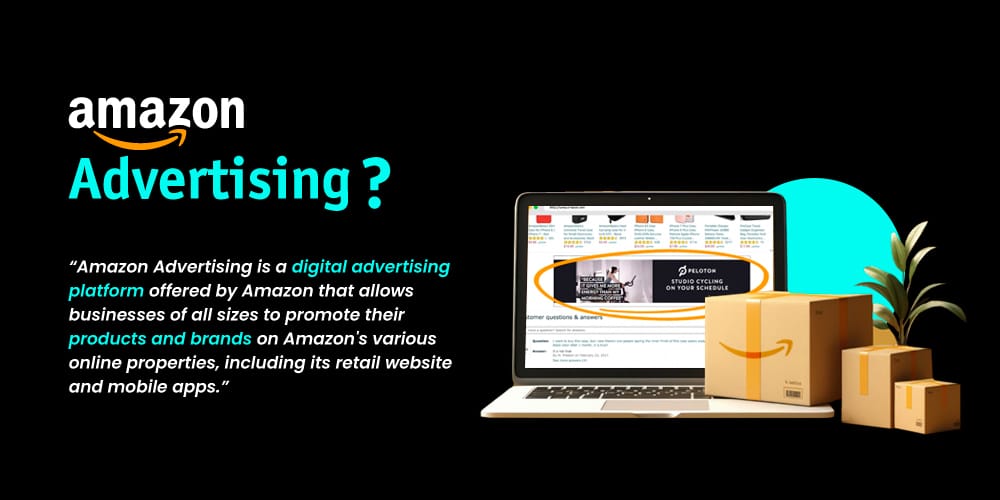
It allows businesses and advertisers to promote their products and services within the Amazon ecosystem, including Amazon.com, Amazon mobile apps, and other affiliated websites and services.
Amazon Advertising can be Segmented into Two Categories:
a. Amazon PPC (Pay-per-click ads)
Amazon PPC is a way for sellers and brands to boost their online product sales that operates on a pay-per-click model similar to Google’s advertising system. This means sellers can create ad campaigns for their brand or products, and when someone interested clicks on the ad, Amazon charges the seller a small fee, regardless of whether a purchase is made.
Factors like the type of ad campaign, the specific targeted keywords, and the level of competition within a particular niche determine the ad costs incurred by the sellers.
How does Amazon PPC work?
Here is the breakdown of how the Amazon pay-per-click works:
- Ad Creation: Sellers or vendors create ad campaigns in their Amazon Seller Central or Vendor Central accounts. They choose products and set up ad groups.
- Keyword Targeting: Sellers select relevant keywords. Ads show when shoppers search for these keywords on Amazon.
- Bidding: Sellers set maximum bids for keywords. Higher bids may improve ad placement but increase cost per click.
- Ad Formats: Sellers can choose from different Amazon PPC ad formats: Sponsored Ads, brand-sponsored ads, and sponsored display ads.
- Auction System: Amazon’s algorithm selects ads based on bid amount, relevance, and quality. The highest bidder with the most relevant ad gets shown.
- Cost Structure: Sellers pay per click, and the cost per click varies with competition and bid amount.
- Performance Monitoring: Sellers track metrics like clicks, impressions, spending, sales, ACOS, and ROAS. They adjust bids, keywords, and budgets based on results.
- Budget Control: Advertisers set daily or lifetime budgets to manage ad spend. Ads stop when the budget is reached.
Types of Amazon PPC Ads
PPC ads cater to professional and Brand Registered sellers on Amazon who aim to expand their customer outreach. This advertising platform is prevalent among Amazon sellers and encompasses ad types like Sponsored Products, Sponsored Brands, and Sponsored Displays.
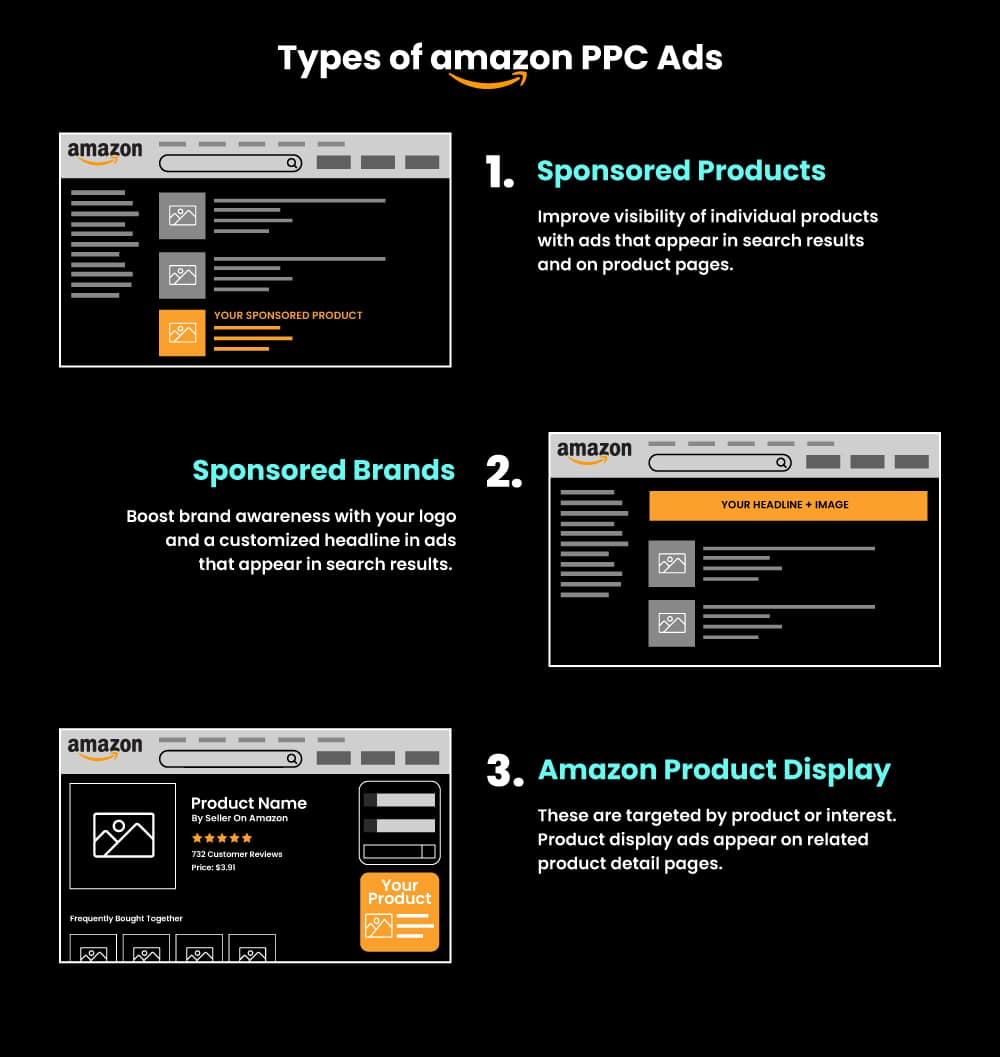
Let’s dive into an explanation of each type:
Sponsored Products
When sellers start Amazon advertising, they usually begin with Sponsored Products campaigns. Interestingly, sellers don’t need to register brands to use this type of advertising. It’s the easiest way to use Amazon’s pay-per-click (PPC) advertising. You can quickly start a Sponsored Products campaign after finding the right keywords through some initial research.
These ads help get more clicks by blending in with the regular search results. They often appear near the top or middle of the first page of results, where about 45% of shoppers decide to buy. Sometimes, they might show up below the expected results on the sides of a product’s page.
Sponsored Products ads are carefully planned using specific keywords matching people’s searches. Once you decide how much to spend on certain keywords, Amazon takes over and shows the ads to the right people. These sponsored product ads tend to work well and are usually cheaper, about three times less expensive than using Google AdWords.
For instance, let’s see what products appear in the search results when customers shop for women’s tops on Amazon.
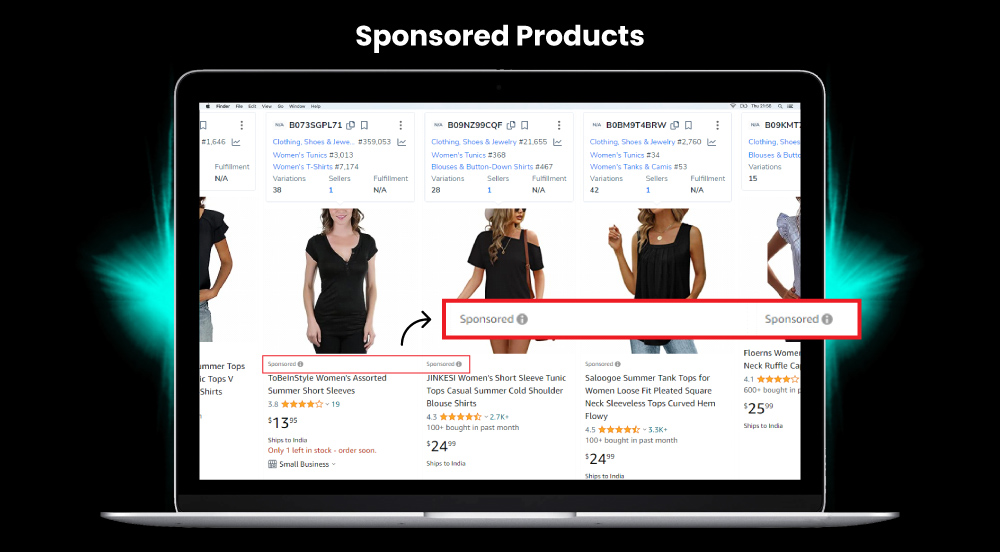
The above image illustrates a scenario in Amazon search results where the first four listings feature a “Sponsored” label. This label signifies that advertisers are specifically targeting the keyword “Women’s Top” to promote these products to users searching for women’s tops.
After analyzing the sales data for these products using the Helium 10 extension, we observed that these products had recently been added to the platform and had shown relatively modest sales figures compared to many organic ranking search results. These products would encounter challenges in reaching the highest positions in the search results if they were not featured in Sponsored Product advertisements.
Note: In case of Sponsored Products Ads both keyword targeting and product targeting campaigns can be run simultaneously. They just need to be set up separately.
Requirements for Amazon Sponsored Products Ads
Here are the general requirements for Amazon Products Ads:
- Amazon Seller Account: Sellers need to have an active Amazon seller account to be eligible to run Sponsored Products ads.
- Product Eligibility: The products sellers want to advertise must be new, in stock, and eligible for the Buy Box.
- Keyword Strategy: Sellers need to choose relevant keywords that shoppers might use to search for products similar to the seller’s.
- Competitive Bids: Sellers need to set competitive bids for their keywords, as higher bids increase the likelihood of displaying their ads.
Cost to run a Sponsored Products Ad
The cost of running a Sponsored Products ad varies depending on elements such as the competitive keywords, the bid amount, and the performance of ads. Sellers can set a budget for their ad campaign and will be charged only when someone clicks on the ad. There’s no specific ad cost; sellers pay per click (PPC).
Benefits of Sponsored Products Ads
Sponsored Products ads offer a range of benefits for sellers seeking to boost their product visibility and sales on e-commerce platforms. These ads allow products to appear prominently on search results and product pages, increasing their discoverability among potential customers.
By leveraging targeted keywords and product-specific targeting, advertisers can reach their desired audience effectively. The PPC pricing model also ensures sellers only pay when users click on their ads, optimizing budget utilization. Overall, Sponsored Products ads enhance brand exposure, drive traffic, and facilitate conversions, making them a valuable tool for e-commerce businesses to achieve their marketing goals.
Also Read: What is the Importance of Backend Keywords in Amazon Listing Optimization
Sponsored Brands (Formerly Headline Search Ads)
Sponsored Brands, previously known as Headline Search Ads, are an advertising format offered by Amazon’s advertising platform. This format is a specific design for brands and sellers aiming to promote their products on Amazon’s platform. Sponsored Brands commonly appear on search result pages, making them a valuable tool for increasing visibility and driving traffic to specific products or product lines.
Sponsored Brand ads typically include a headline, a logo, and multiple product listings. The headline is a customizable text showcasing your brand’s message, while the emblem adds visual recognition. The product listings beneath the headline include images, product names, and brief descriptions, providing potential customers with options to choose from within the brand’s offerings.
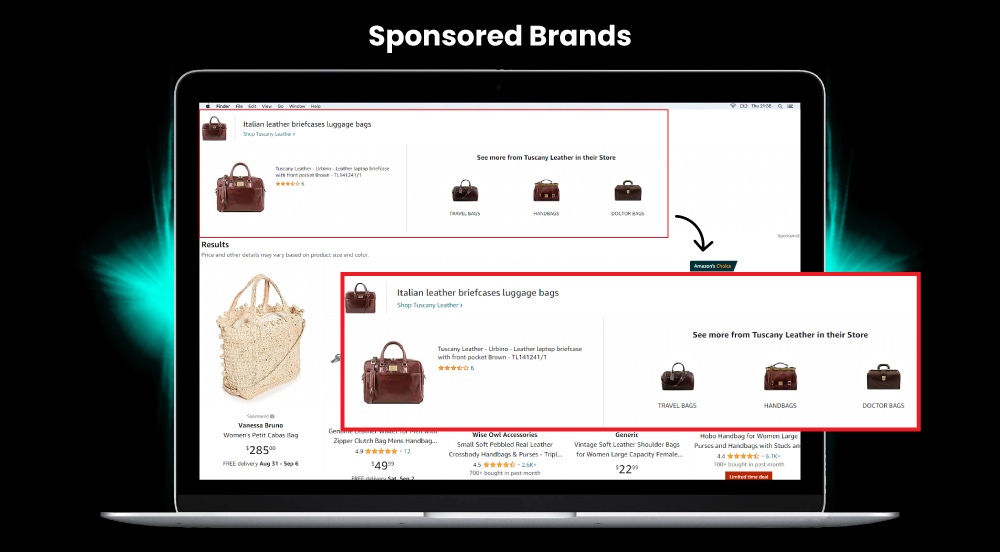
The above image refers to a situation in Amazon Sponsored Brands advertising where Tuscany Leather promotes three different bags from their product range. When a user clicks on any of these individual bags, they are directed to the respective product category page for that specific bag. However, suppose a user clicks the “Shop Tuscany Leather” button. In that case, it leads them to Tuscany Leather’s dedicated Amazon Brand Store, where they can explore the brand’s entire range of leather bags and related products.
Note: Sellers can monitor the performance of their Sponsored brand campaigns through Amazon’s advertising platform, gaining insights into metrics like clicks, impressions, conversion rates, and overall return on investment (ROI). This data helps sellers optimize their campaigns over time for better results.
Requirements for Amazon Sponsored Brands Ads
Sponsored Brands appear in prominent positions on search results pages, helping to drive traffic to specific products or product lines. The general requirements for running Amazon Sponsored Brands ads included:
- Registered Brand: Amazon requires brand registration for eligibility in Sponsored Brands to ensure that the ads align with the brand’s image and offer a cooperative shopping experience for shoppers.
- Products with Buy Box Eligibility: Products with Buy Box eligibility are the ones you intend to advertise. This implies that your products are in new condition, available for purchase, and you hold the “Buy Box” for those products. The Buy Box involves customers initiating the buying process by adding items to their shopping carts.
- Brand Logo and Tagline: A brand logo and a tagline representing your brand are necessary. The Sponsored Brand ad will display these components alongside the products being promoted.
Cost to run a Sponsored Brands Ad
The pay-per-click (PPC) model is the typical choice for Sponsored brand ads on Amazon, where charges accrue each time a shopper clicks on the ad. The actual cost can vary significantly, and there is no universally applicable fixed cost. Users can set a daily budget for the Amazon campaign, and charges will only accrue up to that budget based on the ad performance.
Note: It’s important to note that advertising costs on platforms like Amazon may change over time due to shifts in competition, alterations in consumer behavior, and adjustments in platform policies.
Benefits of Sponsored Brands Ads
Sponsored Brand ads on Amazon provide valuable benefits for sellers:
- They’re prominently displayed in search results, boosting brand visibility.
- They provide performance metrics that offer valuable insights for data-driven campaign optimization.
- These ads help establish a strong online presence.
- They drive traffic to your Amazon store, leading to increased conversions and revenue.
Amazon Product Display
Amazon Product Display Ads, a type of advertising offering provided by Amazon, enable sellers and brands to directly promote their products on Amazon’s platform. These ads have the purpose of increasing product visibility and directing traffic to specific product listings.
Unlike other Amazon ads that primarily appear in search results or sponsored pages, Product Display Ads typically appear on product detail pages. When a shopper views a particular product listing, they may also encounter these ads featuring related or complementary products. The goal is to grab the attention of customers already interested in a particular product and guide them toward considering additional items that might meet their needs.
Product Display Ads provide various targeting options, allowing advertisers to refine their audience and customize their ad placements. Advertisers can choose to target specific products, categories, brands, or even specific customer interests. This level of targeting ensures that the ads reach the most relevant audience, increasing the likelihood of conversions.
Here is an example of Display Ads in action:
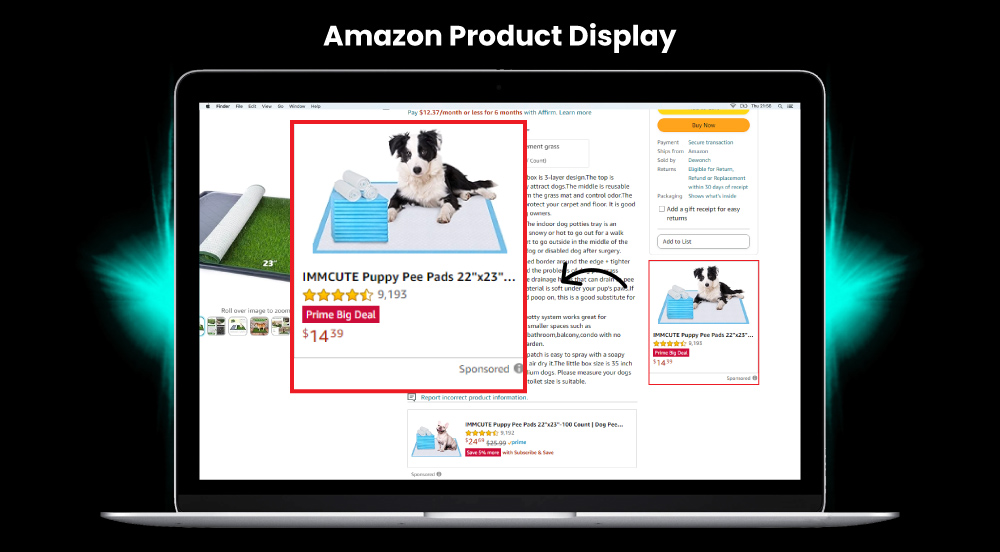
The image above highlights the advantageous feature of Sponsored Display on Amazon, where sellers have the option to target listings for complementary products. An excellent example of this is the Puppy Pee Pad ad, which appears on the far right of the image. While it may not be directly related to the main product, which is the Grass Pee Pads, it serves as a valuable complement to the purchase. This strategic approach enhances the shopping experience, offering customers relevant and useful choices that align with their needs and preferences, ultimately benefiting both sellers and consumers.
Requirements for Amazon Sponsored Display Ads
Here are the general requirements and considerations for Amazon Sponsored Display Ads:
- Seller Account: Sellers need to have a registered Amazon seller account to access Amazon Advertising and create Sponsored Display Ads.
- Product Listing: The products the seller wants to advertise on Amazon must be listed. Each product should have a unique ASIN (Amazon Standard Identification Number).
Also Read: What Is Amazon Listing Optimization?
- Budget: You must set a daily budget for your Sponsored Display Ads campaign. This is the maximum amount you will spend each day on the campaign.
- Ad Creative: Sellers will need creative elements, typically including an image, ad copy, and a headline. Amazon usually provides templates and guidelines for ad creatives.
- Ad Placement: Sponsored Display Ads can appear on and off Amazon’s platform in various locations. This includes product detail pages, customer reviews, search results, and even off-Amazon placements through Amazon’s demand-side platform.
- Ad Approval: Amazon reviews and approves ads before they go live. Ensure that your ad content adheres to Amazon’s advertising policies.
Cost to run a Sponsored Display Ad
Various factors determine the cost of running a Sponsored Display Ad on Amazon through a bidding model. Advertisers set a maximum budget and bid on a cost-per-click (CPC) basis, where they pay for each click on their ad. Competition, ad relevance, and ad quality influence the actual CPC. Your daily budget affects how often your ad displays and your total spending.
Amazon’s platform enables you to control spending by setting budgets and bids, even though there is no fixed cost. This flexibility enables advertisers to customize their campaigns for specific goals and audience targeting, allowing them to make data-driven adjustments to optimize return on investment while effectively reaching their desired audience.
Benefits of Sponsored Display Ads
Sponsored Display ads on Amazon provide valuable benefits for advertisers:
- They let brands and sellers showcase products in various Amazon locations, increasing visibility.
- These ads target active shoppers and expand reach to relevant audiences, boosting brand presence.
- Advertisers can customize ad creatives to convey unique value propositions effectively.
- Robust targeting options help reach specific demographics, and interests, or retarget previous visitors.
- It’s a self-service platform, making campaign setup, monitoring, and adjustment easy.
- Advertisers gain real-time performance insights.
In context, Sponsored Display ads boost brand visibility and offer a cost-effective means to achieve marketing goals on Amazon.
b. Managed-Service Amazon DSP
Amazon DSP (Demand Side Platform) is a managed service option accessible to advertisers and agencies, regardless of whether they have products listed on Amazon. However, unlike PPC ads, which you can set up quickly, you’ll need to connect with an Amazon Advertising account executive to start using Amazon DSP.
Through Amazon DSP, sellers can efficiently purchase display and video ads on a larger scale. Furthermore, advertisers strategically target audiences across various Amazon platforms, including Amazon.com, Fire TV Sticks, IMDb.com, Kindles, and Freedive, as well as on third-party sites, apps, and platforms. Notably, this level of reach and targeting has contributed to the rapid expansion of Amazon’s advertising services.
To know more about Amazon DSP, Click Here…
Why should you Advertise on Amazon?
Advertising on Amazon offers businesses a compelling opportunity to tap into a vast and active customer base.
Amazon has millions of users who shop regularly on the platform. This provides a high-visibility environment for showcasing products and engaging with motivated buyers. Amazon offers sophisticated advertising tools. These include Sponsored Products, Sponsored Brands, and Sponsored Display ads. These tools enable precise targeting and reach across various stages of the buying journey.
Amazon’s robust data insights empower sellers to refine strategies, enhancing ROI. Furthermore, Amazon’s trusted brand and seamless shopping experience foster customer trust, thereby potentially driving conversions and brand loyalty. Moreover, advertising on Amazon grants access to a well-established marketplace, along with providing powerful tools and a captive audience. In summary, Amazon’s platform offers a combination of trust, tools, and audience for advertisers.
This makes it an essential channel for businesses aiming to maximize their online presence and sales potential.
How can Mastroke help create successful Amazon Advertising?
At Mastroke, we specialize in maximizing your presence and sales on Amazon through our dedicated Amazon advertising services. Our team of Amazon experts excels in crafting strategic advertising campaigns tailored to boost your product visibility and drive customer engagement.
Whether it’s optimizing your product listings, managing ads, analyzing advertising performance, or creating compelling ad copy, we have the expertise to elevate your brand’s impact on the platform. Our approach is about boosting your brand’s visibility. It’s about getting people interested in what you offer and ensuring each penny you spend gets you more in return.
Additionally, our content experts work diligently to ensure your product descriptions and advertising content stand out, capturing the attention of potential customers and encouraging conversions. Trust us to navigate the complexities of Amazon advertising, helping your brand thrive in this competitive digital marketplace.
Happy Advertising!
